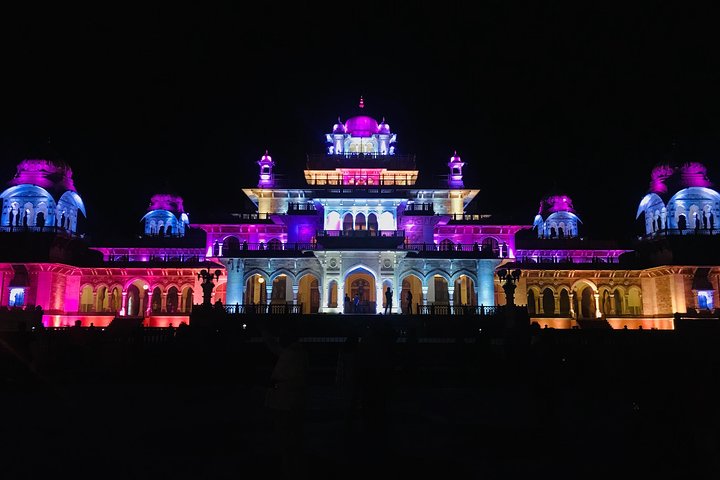Exploring Albert Hall Museum: Jaipur’s Oldest and Grandest Museum
Introduction
Jaipur is a city bursting with history, art, and a vibrant culture that draws travelers from all around the world. Known as the Pink City, Jaipur’s stunning forts, palaces, and bustling markets tell stories of its royal past. Nestled amidst this rich legacy stands the Albert Hall Museum, a symbol of Jaipur’s architectural beauty and cultural pride. It’s the oldest museum in Rajasthan and a true treasure chest for history lovers, art enthusiasts, and curious travelers. Visiting this museum offers a peek into the glorious heritage of Rajasthan and a chance to explore centuries-old artifacts.
History and Heritage of Albert Hall Museum
Origins and Construction– The Albert Hall Museum opened its doors in 1876, during the rule of Maharaja Sawai Ram Singh II. Built to celebrate the royal legacy and serve as a center for arts and archaeology, the museum was designed to impress. Its architecture was inspired by Indo-Saracenic style, mixing Mughal elegance with Rajasthani charm. Renowned British and Indian architects worked together on the project, using local sandstone and traditional crafts. The museum’s grand entrance, with arches and minarets, immediately catches your eye.
Symbolic Significance– More than just a building, the Albert Hall symbolizes Jaipur’s love for arts and culture. It was created to promote Rajasthan’s rich craftsmanship, from jewelry to miniature paintings. The museum reflects the royal taste and artistic skill of the region, presenting artifacts that span thousands of years. When it was founded, the museum became a hub for preserving and showcasing Rajasthan’s unique art forms. It’s a legacy that still stands today.
Evolution Over the Years– Initially serving as a royal gallery, the museum transitioned into a public space over time. Throughout the 20th century, it underwent extensive renovations aimed at expanding its collections and enhancing the quality of its exhibits.. The museum was declared a heritage site, helping to protect its historic architecture. Today, it continues to expand its role as an educational resource and a hub for cultural events. Over the years, it has earned fame as Jaipur’s premier museum.
Architectural Marvels of Albert Hall Museum
Design and Structure– The building’s silhouette is a perfect example of Indo-Saracenic architecture. Its massive façade features domes, minarets, and arched windows, all beautifully crafted with detailed frescoes. The decorative columns and carved stonework showcase intricate Rajasthan motifs. The use of local sandstone gives the structure a warm, earthy tone that blends seamlessly with Jaipur’s desert surroundings. Each detail embodies a harmonious fusion of Mughal grandeur and Rajasthani craftsmanship.
Interior Highlights-Once inside, visitors are greeted by spacious halls filled with artifacts and artwork. The main hall holds sculptures, murals, and decorative items from Rajasthan and beyond. Stained glass windows and ornate ceilings make the interiors even more stunning. The museum takes care to preserve its exhibits using advanced techniques, ensuring that these treasures last for generations. Guided tours and clear signage help visitors appreciate each piece’s story.
Visitor Experience and Accessibility– Getting around the museum is easy if you follow a planned route. The staff is friendly and helps visitors find points of interest. The museum features ramps and accessible pathways for differently-abled guests, making sure everyone can enjoy Rajasthan’s history. Best visiting times are early mornings or late afternoons when the weather isn’t too hot. Be sure to carry a water bottle and wear comfortable shoes for a day of exploration.
Collections and Exhibits at Albert Hall Museum
Archaeological Artifacts– The museum holds a vast collection of ancient sculptures, coins, and pottery. These pieces reveal Rajasthan’s early civilizations, dating back thousands of years. Iconic artifacts include carved stone sculptures from temples and relics of historic trade routes. Each piece connects visitors to the distant past, giving insights into Rajasthan’s ancient culture.
Arts and Crafts-From vibrant textiles to delicate jewelry, the museum showcases Rajasthan’s craftsmanship at its best. Miniature paintings illustrate tales of kings and deities, while traditional Rajasthani attire adds vibrant color to the display cases. Mughal-inspired crafts, like intricate woodwork and embroidery, highlight the region’s diverse influences. The museum also supports local artisans by displaying and selling their work, helping keep traditions alive.
Natural History Section– Apart from art, the museum features a collection of animals, fossils, and minerals. These exhibits are especially popular with school groups and families curious about Rajasthan’s natural environment. Mounted specimens of local wildlife provide educational insights. Conservation efforts are visible through efforts to protect these collections for future generations.
Cultural Events and Educational Programs
Annual Festivals and Events-Throughout the year, the Albert Hall hosts vibrant cultural festivals celebrating Rajasthan’s heritage. Traditional music, dance, and puppet shows fill the museum grounds, creating a lively atmosphere. These events attract both locals and tourists, offering authentic glimpses into Rajasthani culture.
Workshops and Learning Sessions– The museum also runs workshops on arts and crafts, where visitors and students can try their hand at miniature painting or jewelry making. Experts from local communities often lead these sessions, allowing participants to learn directly from masters. The registration process is straightforward, and these programs are designed to make history and art both accessible and engaging.
Digital and Virtual Tours– To reach a global audience, the Albert Hall offers virtual tours and online collections. Now, anyone from anywhere can explore Rajasthan’s art and artifacts through digital platforms. This initiative seeks to foster a deeper appreciation for Rajasthan’s heritage, even from a distance.
Practical Visitor Information
Location and How to Reach-The museum is centrally located in Jaipur, near major landmarks like the Albert Hall park and the Museum Road. You can easily reach it by bus, taxi, or even on foot from nearby attractions. It’s well connected to the city’s main roads, making travel hassle-free.
Opening Hours and Entry Fees– Open from 9 am to 5 pm daily, except on national holidays. Entry fees are modest, with a nominal charge for adults and discounted rates available for students, seniors, and groups. Check the official website for updates and special programs.
Tips for a Memorable Visit– Plan at least 2-3 hours to see everything comfortably. Take your time to read about the artifacts and ask questions. Photography is allowed, but flash photography should be avoided to protect delicate items. Combine your visit with nearby sights like Jantar Mantar or the City Palace for a full Jaipur experience.
Conclusion
Albert Hall Museum isn’t just a building filled with old things; it’s a living record of Rajasthan’s history, art, and culture. From its stunning architecture to its priceless collections, it invites visitors to step back in time and discover the soul of Jaipur. Whether you’re a history buff, an art lover, or just looking for a meaningful experience, this museum should be top of your list. Dive into Jaipur’s story and see its treasures for yourself.
Key Takeaways– The Albert Hall Museum stands as Jaipur’s oldest and most grand cultural landmark.
Its collections offer a fascinating look at Rajasthan’s ancient and modern art, history, and natural heritage.
Planning your visit early, engaging with exhibits, and exploring nearby attractions will maximize your experience.







